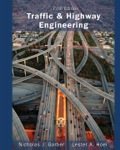
Traffic and Highway Engineering
5th Edition
ISBN: 9781305156241
Author: Garber, Nicholas J.
Publisher: Cengage Learning
expand_more
expand_more
format_list_bulleted
Question
Chapter 9, Problem 9P
To determine
The number of passenger car equivalents.
Expert Solution & Answer
Trending nowThis is a popular solution!

Students have asked these similar questions
2. Vertical highway curve: Given PVI at 65 + 00, L = 800 ft, g1 = +4%, g2 = -3%, and PVI elevation =
264.2 ft, compute the elevations of the curve high point and for all of the full stations until
reaching the end of the curve as well as for the beginning and end of the curve.
1. Horizontal highway curve: Given Pl at 65 + 78.20, A = 22°00', and D = 6°00', compute the
deflections to the nearest second for the full stations (means stations 65+00, 66+00, etc.) as well
as for the beginning and end of the curve.
Water flows uniformly in a channel with a bottom slope of 0.002 and a compound cross-section: Section 1 has concrete sides and bottom. Section 2 is vegetated with light brush. Manning coefficients and dimensions (in meters) are shown below: Calculate: a. The composite Manning roughness coefficient for the channel b. The flow rate in cubic meters per second (cms) for the water levels shown
Chapter 9 Solutions
Traffic and Highway Engineering
Knowledge Booster
Similar questions
- Q2: For the activities shown in the table below, it is required to reduce the total duration of the project four days by using crash program and network diagram, If you knew that indirect costs is 150 S/day and the delay fine is 100 S/day after the 14th day. Find new cost after crashing the project four days? Activity Preceding Normal Program Crash Program activity Duration (days) Direct Cost (S) Duration (days) Direct Cost (S) A 5 600 3 950 B 4 200 3 500 C A 5 300 4 500 D A 2 600 1 615 E B 6 900 5 1025 800 F C 4 700 3 450 400 G D 4 700 700 3 1400 H E 600 I F,G,H 5000 Σ (40 p (good luck)arrow_forwardThe Figure below shows a frame subjected to a uniform load 1kN/m.EI is constant.Compute horizontal displacement and rotation at C. (15Marks) A 3m 5-83m 4m 5m 1kN/m Barrow_forwardI need detailed help solving this exercise from homework of Engineering Mathematics II.I do not really understand how to do, please do it step by step, not that long but clear. Thank you!P.S.: Please do not use AI, thanks!arrow_forward
- I need detailed help solving this exercise from homework of Engineering Mathematics II.I do not really understand how to do, please do it step by step, not that long but clear. Thank you!P.S.: Please do not use AI, thanks!arrow_forwardI need detailed help solving this exercise from homework of Engineering Mathematics II.I do not really understand how to do, please do it step by step, not that long but clear. Thank you!P.S.: Please do not use AI, thanks!arrow_forwardI need solution by handarrow_forward
- I need detailed help solving this exercise from homework of Engineering Mathematics II.I do not really understand how to do, please do it step by step, not that long but clear. Thank you!P.S.: Please do not use AI, thanks!arrow_forwardI need detailed help solving this exercise from homework of Engineering Mathematics II.I do not really understand how to do, please do it step by step, not that long but clear. Thank you!P.S.: Please do not use AI, thanks!arrow_forwardI need detailed help solving this exercise from homework of Engineering Mathematics II.I do not really understand how to do, please do it step by step, not that long but clear. Thank you!P.S.: Please do not use AI, thanks!arrow_forward
- Q1: By using the PERT technique, the durations of the activities were calculated as shown in the table below, Draw an activity network for project by using Activity On Node (AON) method and find: 1. The project's total duration and date of completion and CP (assume the project start date is the 1st of June 2025)? 2. The overall variance of the project? 3. The probability of completing the project in 30 days? 4. The probability of completing the project in 22th of June 2025? 5. With a probability of 75%, what is the expected duration and date for completing the project? Activity Preceding activity K Optimistic duration (day) 4 Most likely duration (day) Pessimistic duration (day) 5 12 L 5 M K 5 11 8 17 11 N K 3 4 11 0 L 2 3 10 P M,N 4 7 10 Q N 3 7 17 R N,O 6 9 18 S P,Q,R 1 3 5arrow_forwardI need detailed help solving this exercise from homework of Engineering Mathematics II.I do not really understand how to do, please do it step by step, not that long but clear. Thank you!P.S.: Please do not use AI, thanks!arrow_forwardI need solution by handarrow_forward
arrow_back_ios
SEE MORE QUESTIONS
arrow_forward_ios
Recommended textbooks for you
 Traffic and Highway EngineeringCivil EngineeringISBN:9781305156241Author:Garber, Nicholas J.Publisher:Cengage Learning
Traffic and Highway EngineeringCivil EngineeringISBN:9781305156241Author:Garber, Nicholas J.Publisher:Cengage Learning Solid Waste EngineeringCivil EngineeringISBN:9781305635203Author:Worrell, William A.Publisher:Cengage Learning,
Solid Waste EngineeringCivil EngineeringISBN:9781305635203Author:Worrell, William A.Publisher:Cengage Learning,

Traffic and Highway Engineering
Civil Engineering
ISBN:9781305156241
Author:Garber, Nicholas J.
Publisher:Cengage Learning

Solid Waste Engineering
Civil Engineering
ISBN:9781305635203
Author:Worrell, William A.
Publisher:Cengage Learning,